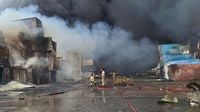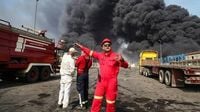A massive explosion rocked the Shahid Rajaï port in southern Iran on Saturday, April 26, 2025, resulting in at least 40 deaths and over a thousand injuries. The incident occurred around noon local time, coinciding with critical nuclear negotiations between Iran and the United States in Oman. Eyewitness accounts and state media reports indicate that the explosion was heard for miles around, causing widespread panic and damage.
The explosion is suspected to be linked to a shipment of sodium perchlorate, a chemical used in solid propellant for missiles, which was reportedly stored in the port. This chemical is known for its explosive potential when improperly handled. The Iranian Red Crescent initially reported 28 fatalities, but this number rose as officials confirmed more casualties throughout the day.
In response to the disaster, Iranian Supreme Leader Ayatollah Ali Khamenei called for a "thorough investigation" into the causes of the explosion. He emphasized the need to uncover any negligence or intentional wrongdoing behind the incident. President Massoud Pezeshkian, who visited the site on Sunday, echoed this sentiment and ordered an immediate inquiry.
As the fire continued to rage, helicopters and water bombers were deployed to combat the flames, which were still not fully extinguished more than 24 hours after the blast. State media reported that the fire was under control but posed ongoing risks due to the presence of hazardous materials.
Authorities have closed schools and offices in Bandar Abbas, the city nearest to the port, and advised residents to stay indoors due to the smoke and potential air pollution from chemicals like ammonia and sulfur dioxide. The Ministry of Health has urged citizens to wear masks if they must go outside.
The Shahid Rajaï port is a critical hub for Iranian trade, handling approximately 85% of the country's goods and situated on the Strait of Hormuz, a vital passage for global oil transport. The explosion has raised alarms about safety protocols at such a key facility, especially given its history; in 2020, a cyberattack attributed to Israel targeted the port.
Initial investigations suggested that the explosion resulted from a fire in a storage area for dangerous chemicals. The Iranian Ministry of Defense has categorically denied that any military-grade materials were involved, stating, "There was and is currently no cargo for military fuel or military use in the area of the fire."
Despite these assurances, the New York Times reported that sources close to the Revolutionary Guards indicated that the explosion was indeed caused by sodium perchlorate, raising questions about the safety of chemical storage practices at the port. Sodium perchlorate is a powerful oxidizer that can lead to explosions if mishandled, and its presence in the port has sparked concerns about the potential for further incidents.
Images from the scene depicted extensive damage, with debris scattered and buildings severely affected by the shockwave. Eyewitnesses reported seeing ambulances rushing to the site as rescue operations unfolded. Videos circulating on social media showed black smoke rising from the port, further illustrating the scale of the disaster.
The Iranian government has declared three days of mourning in the Hormozgan province, where the port is located, and a national day of mourning has been set for Monday, April 28, 2025. The international community has also expressed condolences, with messages of support coming from countries including Saudi Arabia, Pakistan, India, Turkey, and Russia.
As investigations continue, the Iranian government faces mounting pressure to ensure the safety of its critical infrastructure. The incident underscores the delicate balance of managing security and operational safety within a region fraught with geopolitical tensions.
The explosion at Shahid Rajaï port not only represents a tragic loss of life but also highlights the vulnerabilities inherent in the handling of hazardous materials in a volatile environment. As the nation grapples with the aftermath, the implications for Iran's trade, security, and international relations remain to be seen.






